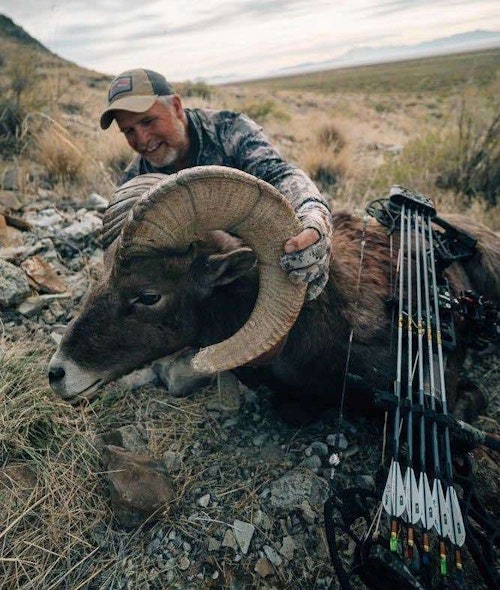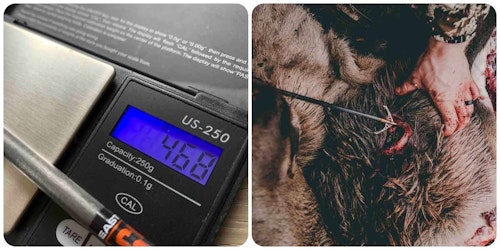
The author took this management bull with a head-on frontal shot, and his 468-grain arrow/broadhead/insert combo buried to the nock. The bull went 35 yards and crashed. (Photo by Darron and Rebecca McDougal)
After 20 minutes of intermittent cow elk calling, the Colorado bull could take it no longer. Bits and pieces of tan and then management-quality antlers suddenly materialized through the thick oak brush. He was beelining straight to me. Go time!
The bull stopped only 15 yards away, raised his head and scanned for cows. My bowsight’s top fiber-optic pin buried on his chest where his coffee-brown mane met his tan brisket. I took the frontal shot, and my arrow — an Easton 6.5 ACU-Carbon 340 shaft tipped with a 2-inch Rage Hypodermic NC — buried to the nock. The young bull whirled, painting everything red in his wake before collapsing only 35 yards down the mountain.
My arrow/broadhead combo weighed 468 grains. Note: This combo included an insert of 22 grains, plus I added two 20-grain Gold Tip FACT weights to the back of the insert, totaling 62 grains. I have the shafts fletched with four Easton BTV vanes, totaling 46 grains, and the nock weighs 6 grains.
The fast and humane kill was the product of perfect arrow placement. Any sensible and accomplished bowhunter will tell you that nothing trumps arrow placement. Period.
Still, that doesn’t diminish the job your arrow-and-broadhead combination has to do. Let’s dive into the weeds on the controversial topic of choosing a deadly arrow setup.
Arrows
In my opinion, the archery and bowhunting community is currently being misinformed by select people and groups that 500- and even 600-grain arrow/broadhead combos are somehow deadlier than anything weighing less. Yes, a 500-grain arrow propelled from a stout bow setup can be deadly, but it doesn’t make you invincible; you still must shoot accurately. Further, advocation for ultra-heavy arrows misses this fundamental point: At a certain weight threshold, you lose more than you gain.
Case in point. One summer when preparing for elk season, I was shooting with my 472-grain arrow/broadhead/insert combo when I wondered if an additional 25 grains of point weight would increase penetration. For perspective, I pull 75 pounds and have a 27.5-inch draw length. I sighted in out to 60 yards with the 497-grain arrow/broadhead/insert combo and did a bunch of shooting. I found that my arrow flight suffered horribly, as did my accuracy. Gaps between my sight pins were huge. And, penetration on my target at 60 yards was the same or less than with my 472-grain arrows.
Mathews Archery’s Joel Maxfield and I discussed some testing he did last summer. “I did an entire summer’s worth of testing with my bow, documenting the differences between a 400-grain arrow and a 600-grain arrow,” he explained. “The 600-grain arrow gained me 3 percent in energy, but yielded a tremendous 27 percent trajectory loss. Far more was lost than gained.
“I don’t understand why people are pushing really heavy arrows. I’m constantly testing, shooting tournaments and bowhunting. I test out lots of different arrow combinations every single year. In the summer, I might fletch 20 dozen arrows. I’ve consistently found that arrows weighing 6.2-7.2 grains per pound of draw weight tune well and maximize accuracy.
“That being said, I don’t build arrows to a specific weight. If a 420-grain arrow tunes and shoots best, I’ll shoot it at any North American big game animal. Same thing with a 482-grain arrow. I build arrow setups that optimize accuracy and performance. That is more important than arrow weight.”
What does this mean for women’s and kids’ bows? Maxfield explained: “Weaker arrow spines for kids’ and women’s bows are obviously lighter (grains per inch) than arrows I shoot from my 72-pound bow. But, since most kids and women shoot less draw weight, it evens out. Again, arrows weighing about 7.2 grains per pound of draw weight typically fly best.”
Maxfield shared one exception: “More than 30 states have a 30-pound minimum draw weight for bowhunting. I don’t recommend 6.2 grains of arrow weight per pound of draw weight with a 30-pound bow. That is too light at just 186 grains. That arrow just won’t perform well. I suggest not going beneath 300 grains.”

Broadheads: Fixed or Mechanical?
If you’ve been bowhunting long enough and have been highly successful, then you know what broadhead works for you. But, if you are looking for some input, you’ll find the following paragraphs helpful.
“I love Rage mechanicals, and I’m not paid to say that,” Maxfield said. “I just finished my North American Super Slam. I shot every animal with a Rage or Rocky Mountain Snyper (an earlier rendition of the same basic rear-deploying design) except for my brown bear; my outfitter asked me not to shoot a mechanical.
“So many folks freak out about mechanicals, especially for big animals like elk. The reality is, I’ve packed out a lot of elk. I’ve killed about 20 bulls with mechanicals and never a 500-grain arrow. The failure stories you read online are just regurgitated misinformation from folks who aren’t making good shots. I’ve witnessed at least 1,000 bow kills in my life, and every animal that was hit as it should have been was recovered.”
The bowhunting community misconceives that it takes a wildly powerful setup to deploy a mechanical broadhead and for it to penetrate. Nonsense.
“One of the engineers at Mathews drew an awesome elk tag last year,” Maxfield said. “He shoots a little less draw weight than I do and also has a shorter draw length. He settled on a 380-grain arrow tipped with a huge Rage Hypodermic Trypan mechanical. Even I was like, ‘Really, dude?’ But, he had total faith in the setup. He shot his bull at about 60 yards, right through the heart, and his arrow actually busted the opposite shoulder.”
According to Maxfield, even lightweight women’s and kids’ setups can be incredibly deadly with mechanical broadheads.
“My wife, Janice, is an avid bowhunter,” Maxfield said. “She pulls 50-pounds with a 25-inch draw length and shoots a 340- to 350-grain arrow — 6.8-7 grains of arrow weight per pound of draw weight. She’s harvested bull elk, bull moose, African game, New Zealand game, probably 20 black bears and around 150 whitetail bucks, just to mentioned some of her accomplishments. Some will cringe at this, but she shoots 2-inch Rage broadheads. Penetration has never been an issue. They just work.”

This isn’t a Rage ad or an advocation for mechanical broadheads in general. It’s just proof that when you shoot a normal arrow weight that maximizes accuracy, you’re likely to make better shots. And when you make a perfect shot with any good broadhead, you’ll get your game. If you’ve tuned your bow with fixed-blade broadheads and they boost your confidence, by all means, use them.
Of course, bows with 40 pounds of draw or less are better suited toward razor-sharp fixed-blade broadheads. A mechanical will probably work just fine, but, penetration is important right behind shot placement. I believe the best penetration for a sub-40-pound bow can be obtained with a scary-sharp fixed-blade head.

Accuracy Is King
Arrows and broadheads are constantly blamed for unrecovered animals. Rarely do bowhunters admit to poor hits due to “pilot error.” Get this: It doesn’t matter how much your arrow weighs or what broadhead you’re shooting. If you make a poor hit, you’ll lose the animal or struggle to find it in most cases.
To that end, don’t use a specific arrow or broadhead just because someone said to. Test and see for yourself what works. Use what deepens your confidence and place your shot correctly. That, my friends, is the recipe for fast, humane kills.
Sidebar: About Lighted Nocks
Lighted nocks help bowhunters find and retrieve their arrows after harvesting animals. This is an important step in assessing a hit and deciding when to begin tracking. But, consider these points before going lit.
Lighted nocks weigh more than conventional nocks. This means your arrows will likely group lower — especially at distance — than with standard nocks. Also, lighted nocks are often shaped or designed differently than the standard nocks included with your arrows. Lighted nocks might be larger and fit tightly between your D-loop knots. This can cause your arrow to leave the bowstring in a flawed manner.
Don’t just plug lighted nocks into your arrows and go hunting. Shoot with them first to see how your arrows fly at various yardages.





